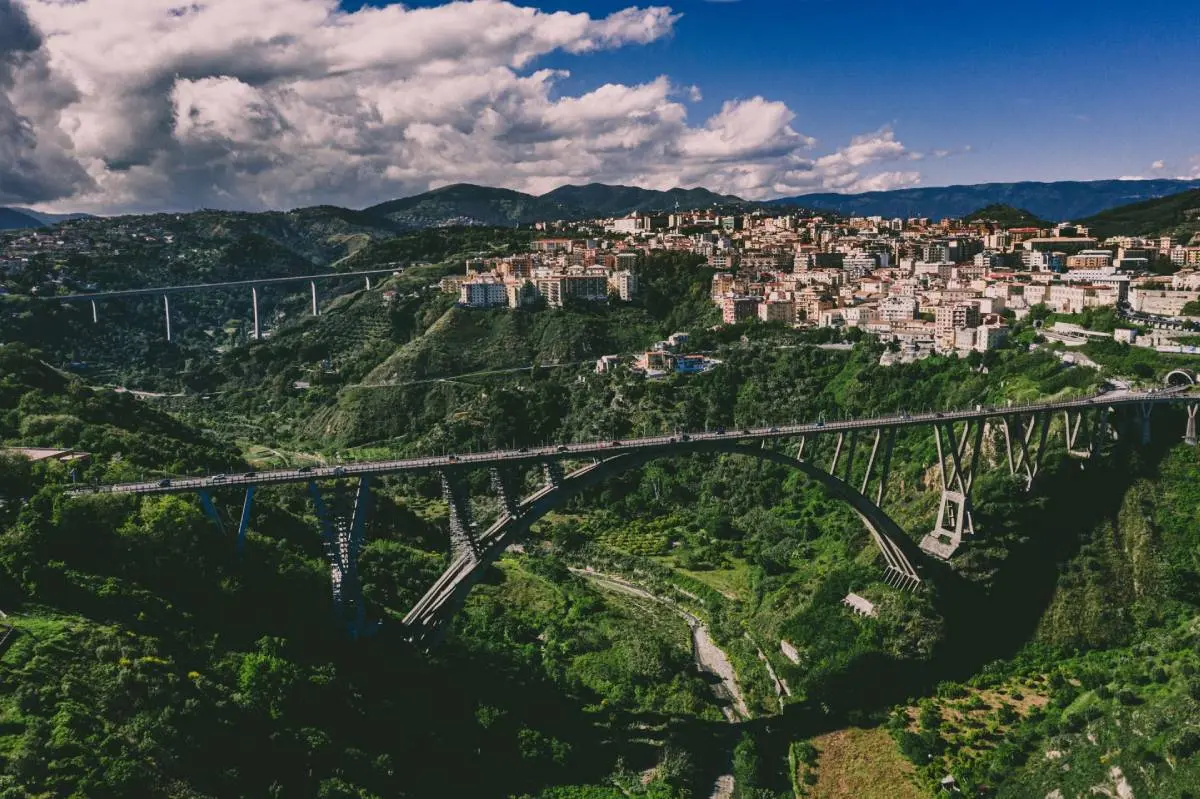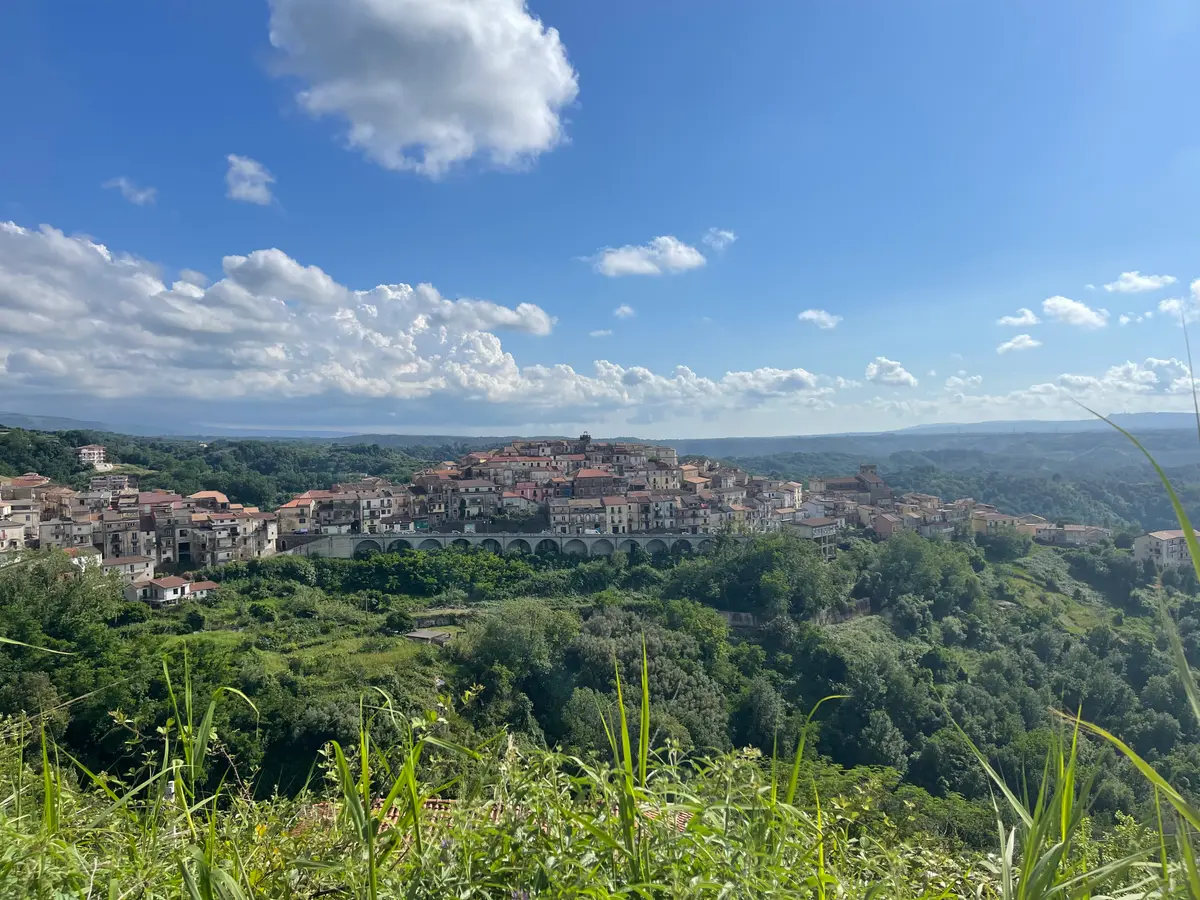Cortale
The historic charm of Cortale's betilo

Historical centres
Cortale is located in the Isthmus of Catanzaro, the narrowest part of Calabria, on a hill that overlooks the vast plains and breathtaking valleys, with beautiful open views of the two seas between the Gulf of S. Euphemia and Squillace.
The historic town centre, despite the earthquakes of 1783 and 1905, today is still a valid reference of the past and the village's antique environment can be breathed in while strolling among alleys surmounted by tunnels in sandstone or climbing the steps that have become a typical landscape feature.
Betilo, a stone which was assigned a sacred purpose as the dwelling of a divinity, displays the oldest inscription of the Magna Graecia.
Cortale's history is almost a thousand years long and began when some Basilian monks settled in the “declivio del Carrà” (mountainside of Carrà), where they founded the Monastery of SS. Anargiri Cosma and Damiano, which made up the original town centre in ancient times. The oldest part of Cortale was destroyed by the earthquake of 1783. Following this disaster, a new village was built where a large part of the population moved to.
Among the monuments of great interest, we find the Chiesa di Santa Maria Cattolica Maggiore built in the XVIII century. At the square's centre, in front of the church, there is a monument to the Italy's Unification by Andrea Cefaly; it consists of a high crenellated base in calcareous stone that supports a terracotta statue representing a woman crowned by a fortress with four crenellated towers holding a crown of flowers in her hand. Noteworthy is the Fontana di Donnafiori, which takes its name from the district with the same name in which it is located; the fountain's water gushes out from six spouts and has a washing unit on the back consisting of four tanks. Of great historical interest is the Lavatoio delle Olive, which represents evidence of industrial archaeology. It was a sophisticated hydraulic olive oil press that allowed to extract oil intended for industrial use from olive residues of surrounding mills.
In order to come into contact with unspoilt nature, breathe pure air and be away from hustle and bustle of city life, visitors are encouraged to go for a walk in the "Bosco Sospeso”, i.e. a park immersed in the woods of the Calabrian Serre located in the area of Cortale.
Local celebrities include painter Andrea Cefaly, who was born in Cortale in 1827. Belonging to an average noble family of Calabria, the painter trained within the cultural environment of Naples. The School of painting that took the name of “Scuola cortalese” was founded in Cortale. Its works reflect moral and patriotic themes as well as literary and religious, without forgetting local landscapes and scenes of family life. Its art can be placed among the experiences of the “verismo napoletano” (Neapolitan realism) and that of the Tuscan Macchiaioli artists.
De.C.O. products and experiences
The municipality of Cortale has established the De.C.O. register, "local designation of origin", for supporting and enhancing the heritage of traditions and local experiences. Products entered under the De.C.O. register are: silk, hand crafted silk is one of the symbols of the town of Cortale (Cortale at the end of the nineteenth century belonged to the so-called silk triangle); beans with over five varieties grown locally; graffiola, a sweet typical of Cortale with very ancient origins which in the past was identified as the sweet for weddings and that in present times it is made by local bakeries.
Cortale's betilo
Within the area of the former abbey of Cortale a stone relic of ancient origins was discovered. The betilo, a stone that was attributed a sacred function as the dwelling of a divinity or due to being identified with the divinity itself, contains the most ancient inscription of the Magna Graecia and is now kept in the Palazzo Valdesi, which is the headquarters of the Soprintendenza Archeologia, Belle Arti e Paesaggio (Superintendence of Archeology, Fine Arts and Landscape) for the provinces of Catanzaro, Cosenza and Crotone. The betilo discovered in Cortale likely dates back to very ancient times. Indeed, it is likely to represent the most ancient inscription of Magna Graecia and Sicily discovered to date. The inscription, still being deciphered, would seem to be a dedication to Hercules of the Forum Boarium and the shape of the betilo adapts well to this cult thus linking it also to the famous myth of the mission carried out by Hercules that brought Geryon’s oxen from Spain to Greece passing by the coasts of Sicily and Calabria. The artefact, containing some engraved letters, has some signs imprinted on the rock covered by a reddish coating, and precisely the shape of the letters and their use evidences belonging to the Achaean era, as neither Magna Graecia, nor Sicily had stone inscriptions that were so ancient.
Gastronomy
Cortale is renowned, in addition to the typical Calabrian cuisine, also for the production of its special beans, entered in the De.C.O. register Lovers of good food can savour this speciality in the many agritourism farms located just outside the village gates.
Useful information
What to know about Cortale
Events
There are 1 events scheduled.
Travel Ideas
There are 1 travel ideas.
Infopoint Cortale
Via F. Turati, 18, Cortale
No result









